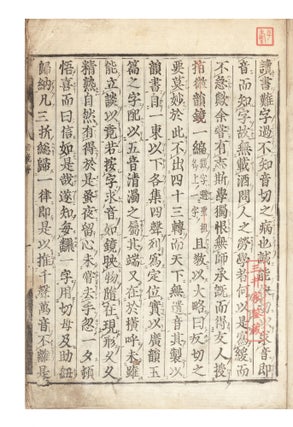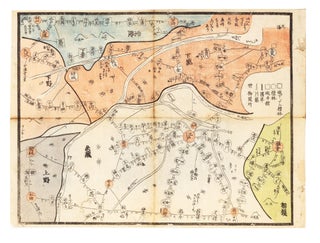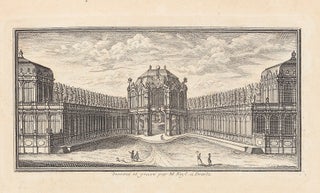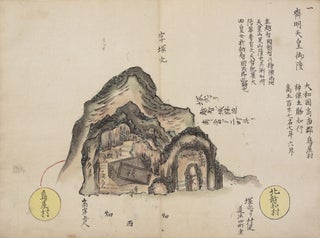Movable Type Dictionary of Renga Poetry
Shozaishu 匠材集 [Dictionary of Renga Poetry [or] Collection of Building Materials].
69; 52; 61; 54 folding leaves. Four vols. Oblong 8vo (140 x 210 mm.), orig. persimmon-stained wrappers (a little worn), new stitching. From the colophon: “1597” (but see below).
First edition of this rare movable type dictionary of renga poetry. This is the earliest Japanese movable type book we have yet encountered (the first book printed in Japan with movable type — using Korean technology — appeared in 1593). It is one of the first dictionaries of renga poetry, written by one of the great masters of the genre. This book is very rare; WorldCat lists only the Kyoto University copy. In 1967, Kawase (Vol. I, p. 559) located a copy at Takagi Bunko.
Poetry has always had a central place in Japanese culture, and renga poetry enjoyed enormous popularity in the 16th and following centuries. Developed in the 13th century, it is linked-verse poetry in which two or more poets collaboratively supplied alternating sections of a poem. Renga poetry formed part of the cultural knowledge of Japanese elite society. The rules and canons of linked poetry were so complex that a number of guides, rule books, and dictionaries appeared, beginning in the 14th century.
Satomura (1524-1602), is considered to be the last great master of renga poetry. A poet, critic, and scholar, “he achieved success by effort, talent, and luck. During his life time, renga became established into houses like waka…
“Although he now is seen as a person of great importance, both as a poet and critic, he has been little studied until recent years, and even now his very large canon has discouraged systematic study. From 1563 he was the central renga figure of his day…
“He was quite simply an outstanding poet, the last of the great renga masters and different from his predecessors…In sum, Joha showed that even in such an age of increasing rigidity it was possible (with genius and good fortune), to be something of a free agent and give renga its last really great hour.”–Earl Miner et al., The Princeton Companion to Classical Japanese Literature, p. 226 & see pp. 365-66.
Along with the creation of renga poetry, Satomura devoted much time to writing a series of critical works of various kinds on renga poetry. The present dictionary, printed in an easy-to-carry oblong format, was an essential aid to the writing of renga poetry. The organization of this highly specialized dictionary is by iroha order. It was compiled primarily to annotate terms in respect to their applicability or usefulness in renga.
Kawase, while giving the printing date as “1597,“ states that other evidence suggests that this book might have been printed between the years ca. 1615-33.
Fine set but with some minor worming repaired. Occasional faint dampstaining. Preserved in a chitsu.
❧ Don Clifford Bailey, “Early Japanese Lexicography” in Monumenta Nipponica, Vol. 16, Nos. 1/2 (1960), p. 29.
Price: $29,500.00
Item ID: 6999

![Item ID: 6999 Shozaishu 匠材集 [Dictionary of Renga Poetry [or] Collection of Building Materials]. Joha 里村紹巴 SATOMURA.](https://jonathanahill.cdn.bibliopolis.com/pictures/6999.jpg?width=768&height=1000&fit=bounds&auto=webp&v=1588723281)
![Shozaishu 匠材集 [Dictionary of Renga Poetry [or] Collection of Building Materials].](https://jonathanahill.cdn.bibliopolis.com/pictures/6999_2.jpg?width=320&height=427&fit=bounds&auto=webp&v=1588723281)
![Shozaishu 匠材集 [Dictionary of Renga Poetry [or] Collection of Building Materials].](https://jonathanahill.cdn.bibliopolis.com/pictures/6999_3.jpg?width=320&height=427&fit=bounds&auto=webp&v=1588723281)
![Shozaishu 匠材集 [Dictionary of Renga Poetry [or] Collection of Building Materials].](https://jonathanahill.cdn.bibliopolis.com/pictures/6999_4.jpg?width=320&height=427&fit=bounds&auto=webp&v=1588723281)



